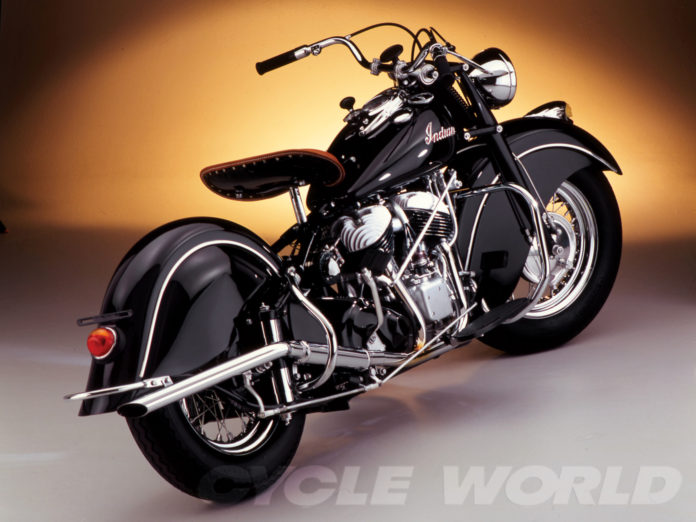High on the list of truths universally acknowledged must be the fact that the Indian Motorcycle, as a legend, a logo and a symbol ranks up there with the golden arches and the three-pointed star, with power and value beyond calculation. On the other hand, naming your daughter Baby Ruth doesn’t ensure she will hit 60 homers a season against big-league pitching. To collect on the promise of legend and esteem, you gotta have a product.
We are concerned here with the Indian, originally spelled Motocycle by the founders, as currently offered by Polaris Industries. To fully appreciate this, we’ll have to look back 60 years, to an undisputed tragedy.
At the close of WWII, a prosperous and product-starved public was ready to buy just about anything. The car and motorcycle makers had learned a lot during the war, but they were canny enough to offer the old versions while testing and refining the new. The 1947 Harley-Davidsons, Fords, Chevys, Dodges, etc., were identical to the 1941 models, while the improved models—the ohv Oldsmobile engine and the telescopic-fork Hydra-Glide—didn’t get here until 1949.
But at the Wigwam, as always, things were different. E. Paul DuPont, who owned Indian and kept the brand in business through the Great Depression, sold his shares in the company. The new owners had new ideas—vision, one could say. The firm’s chief engineer had designed a radical line of really new machines, modular in that there would be a Single, a Twin and a Four, all using the same basic design, all overhead valve, foot shift and hand clutch, suspension fore and aft, with the writing on the tank being the only clue as to what was what.
Further, the new president embarked on a revolutionary ad campaign. As the Japanese say, he reckoned to enlarge the pie, rather than fight over slices. The completely different motorcycles were launched in 1945, with a completely different campaign endorsed by baseball, show business and movie stars.
But wait: Doesn’t this sound like Honda in 1959, meeting the nicest people and all that? Yes. But for one thing, Honda’s dealer network was based on new people who mostly ran hardware or sporting-goods stores, and for another, Honda’s engineering raised the bar worldwide.
Indian’s new bikes—the Single and Twin (the inline-Four never got past the prototype stage)—were disasters. When they didn’t blow up, they broke down. The motorcycling community was small, and everybody knew how bad the new models were. Add to that, the old dealer network, the guys who’d raised a stink when the evergreen Scout was abandoned and stormed the boardroom demanding a new one, wasn’t always that happy with the new people.
Suffice it here to say that everything that could go wrong did. The money ran out and Indian’s new owners begged for help. The English brands were doing well, so Indian asked to distribute several makes. A partnership was formed, and before you could say the camel’s nose was in the tent, the Indian visionaries were out, the English owned Indian and production of the new models was immediately stopped. The final production run of the final genuine Indians, the Blackhawk version of the side-valve 80-inch Chief, came in 1953.
There followed a run of Royal Enfields and later, Matchlesses labeled Indian, but fooling nobody. Next, a puzzle and struggle over ownership of the script, name and symbols. There were Matchless-Indians, then a run of Italian Indians backed by entrepreneur Floyd Clymer, first road bikes and then motocross.
Next, a series of failures on a different stage: promoters with big plans and no money, who never made any motorcycles. A serious effort appeared in 1999. There was a major market at the time for full-dress Harleys and look-alike rivals from the major brands. Indian of America had a factory in Gilroy, California, and produced a viable machine, a big Twin styled like the old Chief and powered by a version of a Harley clone. But the funding wasn’t enough, sales did not meet hopes and the firm went bankrupt in 2003. Three years later, another group of investors picked up the baton and began building the same sort of repro-Indian Chief, this time with modern engineering as in EFI and a bigger V-Twin than Indian Motocycle ever dreamed of—all of it just in time for the bottom to drop out of the market.
But the true revival, one can only hope, came in 2011, when Polaris bought the struggling brand. What’s the difference this time? The lesson since the debacle in 1945 is clear: It’s a heap more difficult to produce a viable motorcycle than all those dreamers and promoters realized. They all had the script and the logo and the legend, but not one had a product to match the hype, good intentions or no.
In contrast, Triumph, with a logo and badge nearly as good, was revived and still thrives simply because it had 1) the capital to invest; and 2) a properly engineered machine that created its own market. It didn’t revise the classic Bonneville Twin until the big Triples proved that the product matched the promotion. Knock wood, those Indian dealers who stormed the boardroom demanding a new Scout in 1947, may soon get their wish. Except there is a very good chance it will be a Chief.
I don’t hear anybody complaining.
Source: Indian Motorcycles- History of America’s Oldest Motorcycle Brand








